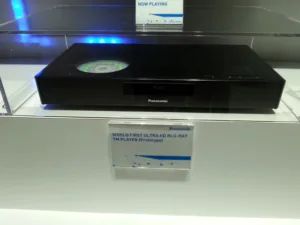At CES 2015, we met with the Blu-ray Disc Association to learn more about how the specification is developing and when we can expect products in the market.
It now looks as though the BDA will begin licensing the new spec in the summer of 2015 with products expected in the market by the end of 2015. As a preview, Panasonic showed the first working Ultra HD Blu-ray player at CES 2015.
Panasonic Ultra HD Blu-ray Player
The BDA is determined to continue to have Blu-Ray represent the best viewing experience that consumers can have. The new standard will include the ability to display HDR content, although the exact specs are still to be decided. The group is apparently going to implement the MovieLabs recommendation for HDR which sets up the structure for how HDR content will be delivered, but does allow for different “flavors” of HDR. That means Dolby Vision and a Philips alternative approach (and perhaps approached by Technicolor and others) can be supported allowing for a differentiated HDR Blu-ray experience.
According to Ron Martin, who is a VP at Panasonic Hollywood Labs and the Vice Chair of the BDA promotion group, the new spec will support the display of 2020 content and will use 10-bit coding per color as well. But as with the current Blu-ray standard, color sub-sampling will be limited to 4:2:0. In terms of frame rate, 24. 25, 30, 50 and 60, plus the fraction frame rates, will all be supported. 120fps will not be supported. The SMPTE 2086 standard which specifies the Perceptual Quantizer method for gray scale steps, will be used as well. This eliminates gamma in favor of steps that better mimic the way the eye sees variations in luminance.
Martin also noted that Blu-ray disc sales are up 5% in 2014 over 2013 so the BDA is optimistic that the new spec will be well received by consumers and industry – despite the growing use of streaming content.
Disc sizes will range from 66GB (dual layer) up to 100GB (triple layer). Playback data rates can go as high as 128 Mbps – far higher than any OTT service.

